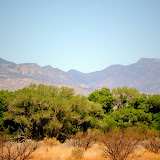Port de Galinhas, Brazil
In late September 2011, two members of the Riparian Resilience team, Lily House-Peters and Christopher Scott traveled to Porto de Galinhas to attend and present at the XIVth World Water Congress. In fact Dr. Scott was led the International Scientific Committee, a commendable feat!
 The theme of the meeting was Adaptive Water Management: Looking to the Future. Lily presented a paper to an international audience interested in ecosystem services and global change titled, "Assessing the impacts of Land Use Change on Water Availability, Management, and Resilience in Arid Region Riparian Watersheds in Southwestern USA and Northern Mexico." The paper compared possible impacts to ecosystem service provisions, such as food, fiber, fuel, nutrient regulation, and erosion control, in each watershed under possible alternative futures. The paper stresses important link between maintaining the resilience (ie. functionality of the riparian system) and maintaining the ecosystem services that human communities rely on in the region. For example, if in the future there is limited winter precipitation with no flooding, the cottonwood tree forest in the riparian corridor would be vulnerable because seed dispersal and propagation depends on winter flood dynamics. The loss of the cottonwood forest would result in reduced erosion control, negatively impacting the livelihoods of farmers who cultivate land in the floodplain. This is especially important in the Rio San Miguel basin in Sonora, Mexico, where there is substantial flood plain agriculture.
The theme of the meeting was Adaptive Water Management: Looking to the Future. Lily presented a paper to an international audience interested in ecosystem services and global change titled, "Assessing the impacts of Land Use Change on Water Availability, Management, and Resilience in Arid Region Riparian Watersheds in Southwestern USA and Northern Mexico." The paper compared possible impacts to ecosystem service provisions, such as food, fiber, fuel, nutrient regulation, and erosion control, in each watershed under possible alternative futures. The paper stresses important link between maintaining the resilience (ie. functionality of the riparian system) and maintaining the ecosystem services that human communities rely on in the region. For example, if in the future there is limited winter precipitation with no flooding, the cottonwood tree forest in the riparian corridor would be vulnerable because seed dispersal and propagation depends on winter flood dynamics. The loss of the cottonwood forest would result in reduced erosion control, negatively impacting the livelihoods of farmers who cultivate land in the floodplain. This is especially important in the Rio San Miguel basin in Sonora, Mexico, where there is substantial flood plain agriculture.The World Water Congress meeting was held in Porto de Galinhas, a small town located on the Northeastern coast of Brazil. The location was stunning, including a natural reef replete with colorful tropical fish.
Natural pool in the coral reef at low tide
Tropical fish in the reef
Eel
In addition to attending the conference in Porto de Galinhas, there was time to visit the large city of Recife and the UNESCO heritage site, Olinda, a colonial town 15 miles north of Recife.
Recife, Brazil
Downtown Recife
Fishing community in Recife
Colonial style buildings in Olinda
Cathedral in Olinda
Colorful parrot in Olinda



